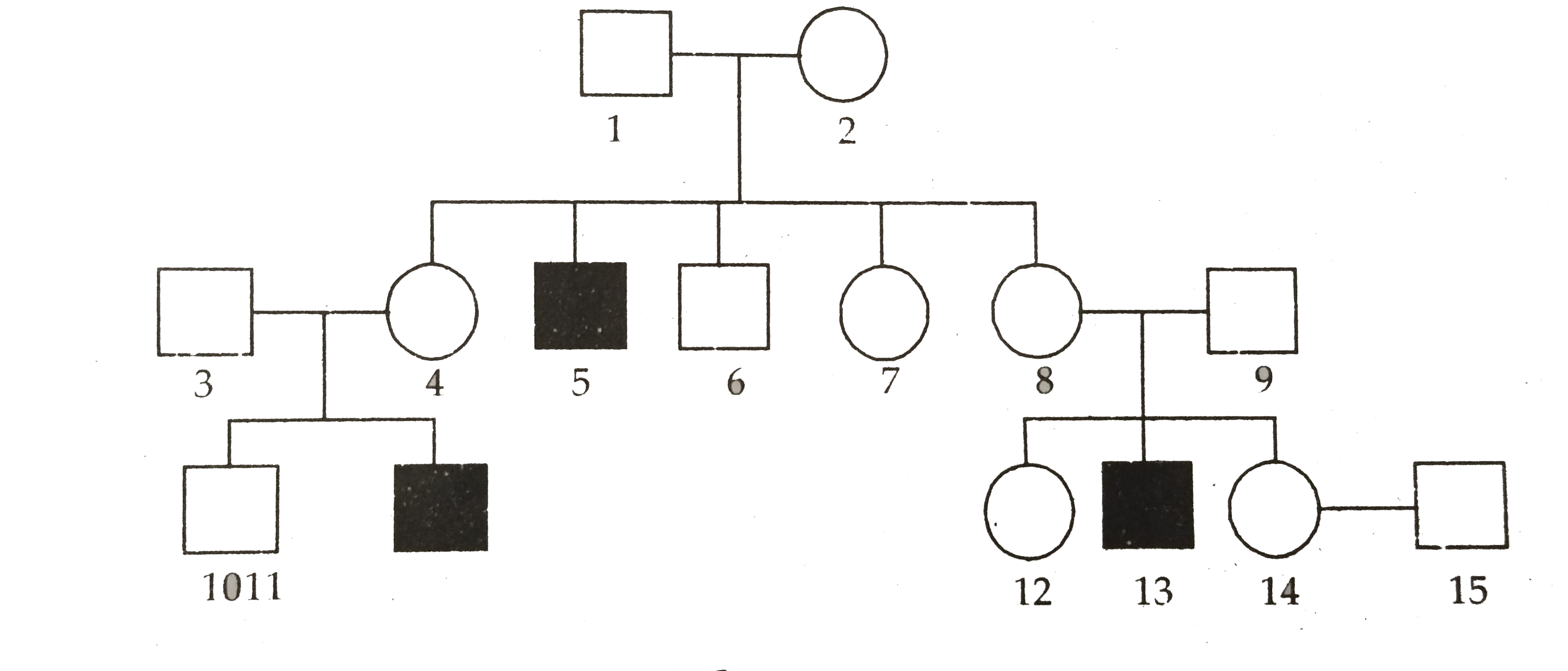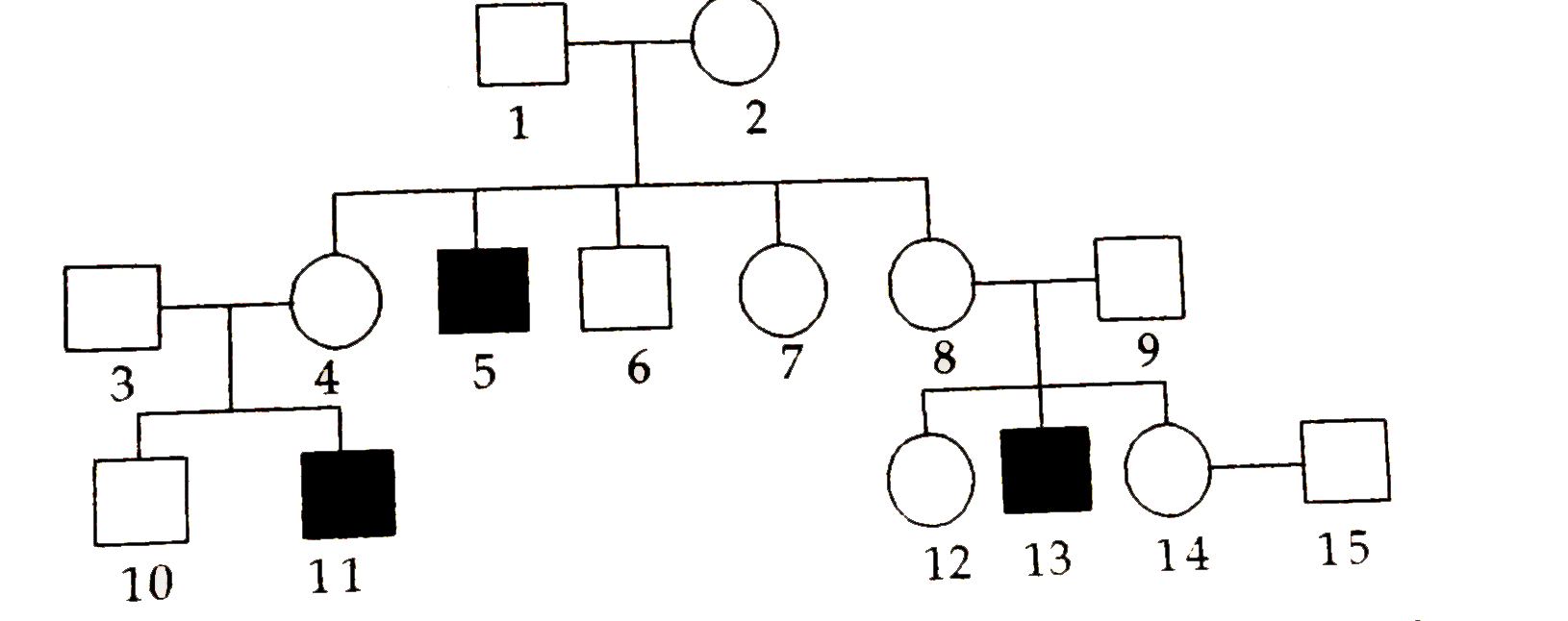Give an example of a sex-linked recessive disorder in humans.
Step-by-Step Solution:
1. Understanding Sex-Linked Recessive Disorders:
- A sex-linked disorder is caused by mutations in genes located on the sex chromosomes (X or Y). In humans, the 23rd pair of chromosomes are the sex chromosomes.
- Recessive disorders occur when both alleles for a trait are recessive, meaning that the dominant allele is absent.
2. Types of Sex-Linked Disorders:
- There are two types of sex-linked disorders: X-linked and Y-linked.
- X-linked disorders are caused by mutations on the X chromosome, while Y-linked disorders are caused by mutations on the Y chromosome.
3. Example of a Sex-Linked Recessive Disorder:
- Hemophilia is a well-known example of a sex-linked recessive disorder in humans.
- It is specifically classified as an X-linked recessive disorder.
4. Genetics of Hemophilia:
- In hemophilia, the mutation occurs on the X chromosome.
- For males (XY), the genotype must be XhY (where Xh represents the mutated allele). Since males have only one X chromosome, the presence of the recessive allele (Xh) leads to hemophilia.
- For females (XX), there are two scenarios:
- If the genotype is XHXh (one normal allele and one mutated allele), the female will be a carrier but will not express hemophilia because the dominant allele (XH) suppresses the recessive allele (Xh).
- If the genotype is XhXh (two mutated alleles), the female will express hemophilia because there is no dominant allele to suppress the recessive alleles.
5. Conclusion:
- Therefore, hemophilia serves as a prime example of a sex-linked recessive disorder in humans, illustrating how the presence of recessive alleles on the X chromosome can lead to the expression of the disorder.
---
- A sex-linked disorder is caused by mutations in genes located on the sex chromosomes (X or Y). In humans, the 23rd pair of chromosomes are the sex chromosomes.
- Recessive disorders occur when both alleles for a trait are recessive, meaning that the dominant allele is absent.
- There are two types of sex-linked disorders: X-linked and Y-linked.
- X-linked disorders are caused by mutations on the X chromosome, while Y-linked disorders are caused by mutations on the Y chromosome.
- Hemophilia is a well-known example of a sex-linked recessive disorder in humans.
- It is specifically classified as an X-linked recessive disorder.
- In hemophilia, the mutation occurs on the X chromosome.
- For males (XY), the genotype must be XhY (where Xh represents the mutated allele). Since males have only one X chromosome, the presence of the recessive allele (Xh) leads to hemophilia.
- For females (XX), there are two scenarios:
- If the genotype is XHXh (one normal allele and one mutated allele), the female will be a carrier but will not express hemophilia because the dominant allele (XH) suppresses the recessive allele (Xh).
- If the genotype is XhXh (two mutated alleles), the female will express hemophilia because there is no dominant allele to suppress the recessive alleles.
- Therefore, hemophilia serves as a prime example of a sex-linked recessive disorder in humans, illustrating how the presence of recessive alleles on the X chromosome can lead to the expression of the disorder.
Topper's Solved these Questions
- XII BOARDSBOOK - XII BOARD PREVIOUS YEAR PAPER ENGLISHCHAPTER - XII BOARDSEXERCISE - DELHI BOARD : SET-II SECTION-B
5 Videos
- XII BOARDSBOOK - XII BOARD PREVIOUS YEAR PAPER ENGLISHCHAPTER - XII BOARDSEXERCISE - DELHI BOARD : SET-II SECTION-E
3 Videos
- XII BOARDSBOOK - XII BOARD PREVIOUS YEAR PAPER ENGLISHCHAPTER - XII BOARDSEXERCISE - [SET -I] [Comptt.] SECTION-E
6 Videos
- SAMPLE PAPER 2019BOOK - XII BOARD PREVIOUS YEAR PAPER ENGLISHCHAPTER - SAMPLE PAPER 2019EXERCISE - Section E Part B
3 Videos
Similar Questions
______ is an example of X-linked recessive trait
View SolutionWhich one of the following is an example of an autosomal recessive disorder?
View SolutionHaemophilia is a sex-linked recessive disorder of humans. The given pedigree chart shows the inheritance of haemophilia in one family. Study the pattern of inheritance and answer the questions given.
(a) Give all the possible genotypes of the members 4, 5 and 6 in the pedigree chart. (b) A blood test shows that the individual 14 is a carrier of haemophilia. The member number 15 has recently married the member numbered 14. What is the probability that their first child will be a haemophilic male?

View SolutionAn X- linked recessive trait is
View SolutionHaemophilia is a sex linked recessive disorder of humans. The pedigree chart given below shows the inheritance of haemophilia in one family. Study the pattern of inheritance and answer the questions given

Give all the possible genotypes of the members 4,5 and 6 in the pedigree chart.
(b) A blood test shows that the individual 14 is a carrier of haemophilia. The member numbered 15 has recently married the member numbered 14. What is the probability that their first child will be a haemophilic male? Show with the help of Punnett square.
View SolutionHaemophilia is a sex linked recessive disorder of humans. The pedigree chart given below shows the inheritance of Haemophilia in one family. Study the pattern of inheritance and answer the questions given.

(a) Give all the possible genotypes of the members 4, 5 and 6 in the pedigree chart.
(b) A blood test shows that the individual 14 is a carrier of gaemophilia. The member numbered 15 has recently married the member numbered 14. What is the probability that their first child will be a haemophilic male ? Show with the help of Punnett square.
View SolutionLesch Nyhan disease is an X-linked recessive disorder that causes neurological damage in human beings. A survey of 500 males from a caucasion population revealed that 20 were effected with this disorder. What is the frequency of the normal allele in this population ?
View SolutionRead following statements (1-4).
1. In transcriptoin, adenine pairs with uracil.
2. Regulation of lac operon by repressor is referred to as positive regulation.
3. The human genome has approximately 50,000 genes.
4. Haemophilia is a sex - linked recessive disease.
How many of the above statements are right ?
View SolutionWhich dieases is sex linked recessive disease ?
View SolutionPic out the correct stataments
(I) Haemophilia is a sex-linked recessive disease
(II) Down's syndrome is due to aneuploidy
(III) Phenylketonuria is an autosomal dominant gene disorder
(IV) Phenylketonuria is an autosomal recessive gene disorder
(V) Sickle-cell anaemia is an X-linked recessive gene disorder
View Solution
